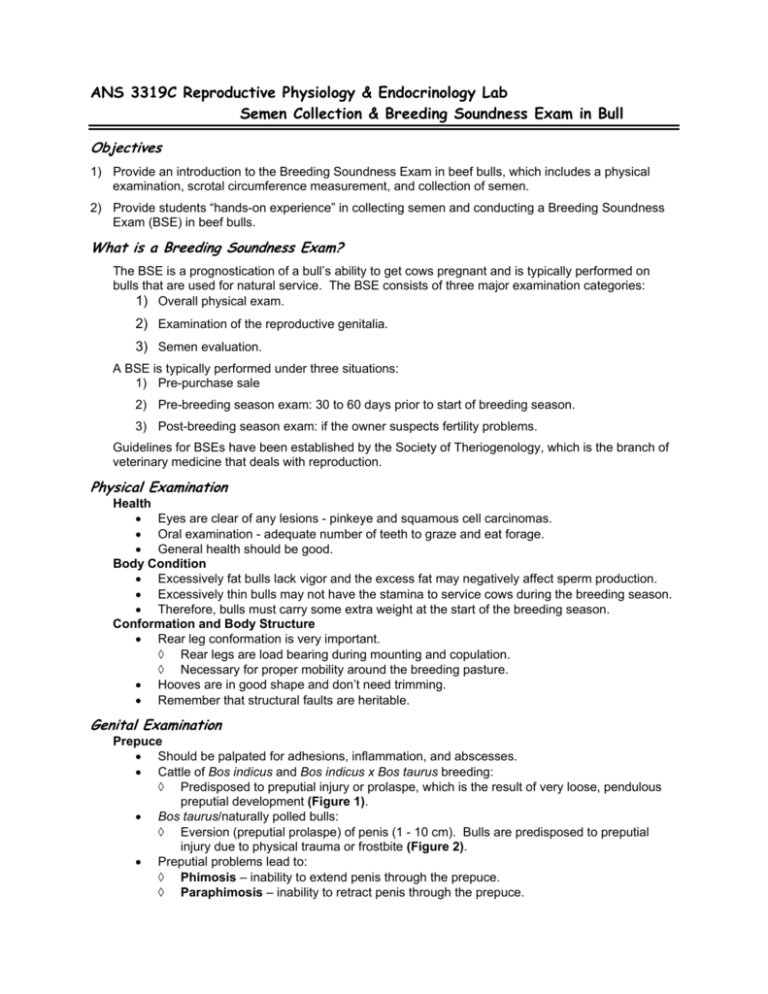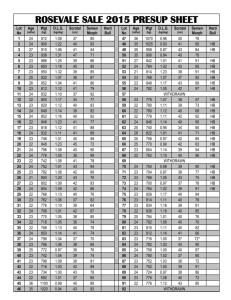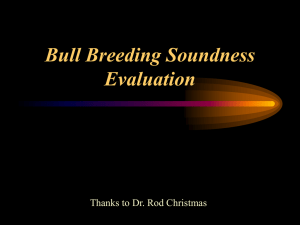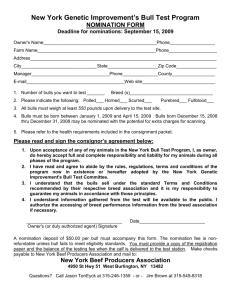Semen Collection & Breeding Soundness Exam
advertisement

ANS 3319C Reproductive Physiology & Endocrinology Lab Semen Collection & Breeding Soundness Exam in Bull Objectives 1) Provide an introduction to the Breeding Soundness Exam in beef bulls, which includes a physical examination, scrotal circumference measurement, and collection of semen. 2) Provide students “hands-on experience” in collecting semen and conducting a Breeding Soundness Exam (BSE) in beef bulls. What is a Breeding Soundness Exam? The BSE is a prognostication of a bull’s ability to get cows pregnant and is typically performed on bulls that are used for natural service. The BSE consists of three major examination categories: 1) Overall physical exam. 2) Examination of the reproductive genitalia. 3) Semen evaluation. A BSE is typically performed under three situations: 1) Pre-purchase sale 2) Pre-breeding season exam: 30 to 60 days prior to start of breeding season. 3) Post-breeding season exam: if the owner suspects fertility problems. Guidelines for BSEs have been established by the Society of Theriogenology, which is the branch of veterinary medicine that deals with reproduction. Physical Examination Health • Eyes are clear of any lesions - pinkeye and squamous cell carcinomas. • Oral examination - adequate number of teeth to graze and eat forage. • General health should be good. Body Condition • Excessively fat bulls lack vigor and the excess fat may negatively affect sperm production. • Excessively thin bulls may not have the stamina to service cows during the breeding season. • Therefore, bulls must carry some extra weight at the start of the breeding season. Conformation and Body Structure • Rear leg conformation is very important. ◊ Rear legs are load bearing during mounting and copulation. ◊ Necessary for proper mobility around the breeding pasture. • Hooves are in good shape and don’t need trimming. • Remember that structural faults are heritable. Genital Examination Prepuce • Should be palpated for adhesions, inflammation, and abscesses. • Cattle of Bos indicus and Bos indicus x Bos taurus breeding: ◊ Predisposed to preputial injury or prolaspe, which is the result of very loose, pendulous preputial development (Figure 1). • Bos taurus/naturally polled bulls: ◊ Eversion (preputial prolaspe) of penis (1 - 10 cm). Bulls are predisposed to preputial injury due to physical trauma or frostbite (Figure 2). • Preputial problems lead to: ◊ Phimosis – inability to extend penis through the prepuce. ◊ Paraphimosis – inability to retract penis through the prepuce. ANS 3319C Reproductive Physiology & Endocrinology Lab - Semen Collection & Breeding Soundness Exam in Bull Figure 1. A very pendulous development of the prepuce, which predisposes to preputial lesions (left) compared with a more desirable conformation (right) in Bos indicus. Penis (Figure 2) • Penile frenulum ◊ Developmental characteristic observed in virgin bulls. • Penile deviations ◊ During extension, penis should be parallel to the body of the bull. • Other penile abnormalities. Figure 2 Figure 9 Scrotum • Variations in normal scrotal conformation (Figure 3). • Abnormal scrotal conformations (Figure 4). • Scrotal circumference measurement (see later section). • Cryptorchidism is the failure of testis to descend into scrotum (unilateral or bilateral). ◊ Unilateral - one testicle is retained and bulls are generally fertile. This is a heritable trait and bulls are usually not used for breeding. ◊ Bilateral - both testicles are retained and bulls are infertile. 2 ANS 3319C Reproductive Physiology & Endocrinology Lab - Semen Collection & Breeding Soundness Exam in Bull Figure 3. Variations of scrotal conformation. A) Normal scrotal conformation with elongated testes. B) Normal scrotal conformation with rounded testes. C) Scrotum may be rotated in some bulls with no apparent ill-effects. D) Cleavage between caudal epididymes is sometimes very distinct. 3 Figure 4. Any deviation from normal scrotal conformation usually leads to a poor prognosis. A) Testes held close to the body wall are usually small or hypoplastic. B) Unilateral hypoplasia. C) Scrotal hernia. D) Incomplete descent of right testis. Testes & Epididymes • Palpate the testes and epididymes for size, tone, and symmetry. ◊ Testes should be firm; but, they should not be too soft or too hard. ◊ Symmetrical shape is normal. Any deviation in size, shape and/or position should be viewed with suspicion. ◊ Caput, corpus, and cauda are palpated to determine if there are lesions or enlargements. Accessory Sex Glands • Examined via rectal palpation. ◊ Vesicular glands, prostate gland, pelvic urethral muscle, and ampullae. • Seminal vesiculitis is a common problem. ◊ Condition characterized by firm vesicular glands accompanied by inflammation of vas deferens, ampullae, epididymes, or testes with increased white blood cells in the semen. Measuring & Importance of Scrotal Circumference (SC) • Scrotal tape is used to measure area at the largest diameter (cm) of the scrotum (Figure 5). • Highly repeatable measurement when taken correctly. • Most accurate indicators of puberty in bulls. Mean SC at puberty is 28 cm 6 ◊ Puberty is defined as an ejaculate with 50 × 10 sperm with at least 10% motility. • Accurate predictor of: ◊ Sperm output in young bulls. ◊ Bulls with larger SC have increased spermatozoa production. ◊ Future characteristics of the testes and sperm producing ability in young bulls. • Favorably related to semen traits. ◊ As SC increases, sperm motility and normal sperm numbers increase, while abnormal sperm concentrations decrease. • Testicular degeneration ◊ A result of heat or cold stress, systemic infections, trauma, nutritional factors, and other causes, such as degeneration of the seminiferous epithelium. • Allows for determination of potentially sub-fertile bulls. ANS 3319C Reproductive Physiology & Endocrinology Lab - Semen Collection & Breeding Soundness Exam in Bull 4 Figure 5. Correct method for measurement of scrotal circumference. The testes are pulled firmly into the lower part of the scrotum by encircling its base with the hand and pulling down on the testes (A). The scrotal tape is formed into a loop and slipped over the scrotum and pulled up snugly around the greatest diameter of the scrotal contents. The thumbs and fingers should be located on the side of the scrotum rather than between the testes (B) to prevent separation of the testes and inaccurate measurement. A B ◊ Reference Table for SC • The following table lists the minimum recommended SC measurements that a bull must have, within an age category, to pass a BSE. Age Scrotal Circumference (cm) < 15 months 30 > 15 < 18 months 31 > 18 < 21 months 32 > 21 < 24 months 33 > 24 months 34 Minimum Recommended SC for BSE. ANS 3319C Reproductive Physiology & Endocrinology Lab - Semen Collection & Breeding Soundness Exam in Bull Semen Collection Artificial Vagina (AV) • Collection device consisting of a hard tubular casing with a rubber inner liner filled with warm water to stimulate the bull’s penis via temperature and pressure. Collecting funnel is attached to end of casing to which an insulated test tube is attached that collects the semen. • Requires training the bull to mount another animal or dummy. During the erection process the penis is diverted into the AV and the bull ejaculates in it. • Collecting bulls with an AV provides the best quality ejaculate that is typically used by bull studs for semen that is to be frozen. Photos: R. Bowen Colorado State University Electroejaculation • Most common method of semen collection used during a BSE in beef bulls. • Materials needed: ◊ Restraining device or squeeze chute to hold the bulls. ◊ Rectal probe that contains ventral electrodes that stimulate the area near the pelvic-urethra when initiated by the operator (See picture to right). ◊ Power supply attached to the rectal probe to provide an electrical current. • Principle: short bursts of electricity delivered over a continuous but increasing pattern stimulate muscle contractions of the pelvic urethral area that initiate the erection process, protrusion of the penis from the sheath, and eventual ejaculation of semen. 5 ANS 3319C Reproductive Physiology & Endocrinology Lab - Semen Collection & Breeding Soundness Exam in Bull 6 Semen Examination Visual Examination of Semen • Volume ranges between 1 to 6 ml. • Gross appearance should be creamy white, which is indicative of high sperm concentration. • Free from contaminants including blood, urine, dirt, or pus. Motility • Gross motility - mass swirling movement of semen. • Individual motility - strong forward progressive movement as a percentage of the sample. Sample diluted with physiologic saline or sodium citrate. Numerous factors can influence motility including fractionation of semen sample, presence of urine, environmental insults, inadequate dilution techniques and temperature. • Because so many different factors can influence motility, it is the least predictable, and therefore carries less influence on the final outcome of the BSE. Gross Motility Rating Individual Rapid swirling Very good > 70% Slower swirling Good 50 - 69% Generalized oscillation Fair 30 - 49% Sporadic oscillation Poor < 30% Minimum recommended motility is 30% or Fair for BSE. Morphology • 800 - 2,000 million sperm/ml of ejaculate or 5 - 15 billion sperm/ejaculate. • Determined by evaluating stained (eosin-nigrosin stain is most common) semen smears under a microscope. • Minimum recommended normal sperm in an ejaculate is 70% to pass a BSE. • Sperm abnormalities (Figures 6 and 7) • • Characterization of abnormalities ◊ Primary Underdeveloped Double forms Narrow heads Acrosome defects Crater defect on head Pear-shaped heads Abnormal head contour Small and free abnormal heads Abnormal midpiece Proximal droplet Strongly folded or coiled tail Accessory tails ◊ Secondary Small normal heads Giant and short broad heads Free normal heads Abaxial implantation Distal droplet Simple bent tail Terminally coiled tail Detached, folded, loose acrosomal membranes ◊ Other cells Epithelial cells RBC WBC Sperm precursor cells Others A high prevalence of abnormal sperm (25% of total in ejaculate) can reduce the fertility of the male. Although some sperm with abnormalities can fertilize an oocyte, early embryonic death can result due to an aberration in the developmental pattern of the embryo. • Figure 6. Major sperm abnormalities. A) Proximal cytoplasmic droplets. B) Pyriform heads. C) Strongly folded or coiled tails, tails coiled around the head. D) Middle piece defects. E) Maldeveloped. F) Craters. a b Figure 7. Minor sperm abnormalities. A) Distal cytoplasmic droplets. B) Tailless normal heads. C) Simple bend or terminally coiled tails. D) Narrow, small, or giant heads. E) Abaxial implantation. F) Abnormal acrosomes (ruffled, detatched). Figure 8. Examples of sperm abnormalities a) Three normal sperm & one misshapen head b) Two headed sperm and detached head. c) Coiled tail d) Misshapen head and also proximal droplet e) Distal droplet Slides are located at the following web page (R Bowen): http://www.vivo.colostate.edu/hbooks/pathphys/reprod/seme neval/morph.html d c e ANS 3319C Reproductive Physiology & Endocrinology Lab - Semen Collection & Breeding Soundness Exam in Bull 8 Final BSE Classifications Classification of Bull after BSE has been performed • The attending veterinarian will typically provide a BSE form (see last two pages of handout), which provides the final evaluation information from the BSE and the certification of each bulls’ evaluation. Bulls are classified into one of three categories: 1. Satisfactory Potential Breeder Bull must pass a physical examination. Bull must meet the minimum values for: Scrotal circumference: for it’s age (see SC table). Motility: >30%. Morphology: >70% normal. A bull placed in this classification is ready to breed cows. 2. Unsatisfactory Potential Breeder The bull does not meet either one or several of the minimum BSE values. Bulls that are in this category will not be sold as breeding bulls. 3. Classification is deferred at evaluator’s discretion A bull can undergo a re-examination a later date to determine if he can be placed in the Satisfactory Potential Breeder category. • A producer is not required to have his or her bulls’ semen tested. However, it is a highly recommended reproductive management practice since an infertile bull can’t get cows pregnant. The bull is not out there for the females to admire, his job is to breed cows and get them pregnant. • Bulls in a standardized performance test, collected by a bull stud for freezing, or sold by a purebred producer are almost always evaluated with a BSE. • Although not evaluated during a BSE, it is important that a bull has libido and mating ability. ◊ ◊ ◊ ◊ ◊ Libido is defined as the willingness and enthusiasm of the bull to mount and attempt to service the female. It is also known as sex drive. Mating ability is the bull’s ability to complete the service. There are tests that can be conducted by qualified individuals who make both subjective and objective assessments of a bull’s libido and mating ability. Therefore, it would serve producers well to observe their bulls in the act of mating females in estrus at the start of the breeding season. Make sure that the bull can adequately mount the female, extend his penis, and penetrate the vagina with his penis resulting in successful copulation. The mating process should be a quick and natural process. Remember, just because he looks like a bull and he has all the right equipment, it doesn’t necessarily mean he can get the job done. ANS 3319C Reproductive Physiology & Endocrinology Lab - Semen Collection & Breeding Soundness Exam in Bull 9 ANS 3319C Reproductive Physiology & Endocrinology Lab - Semen Collection & Breeding Soundness Exam in Bull 10



